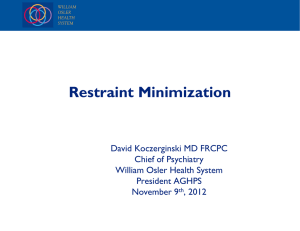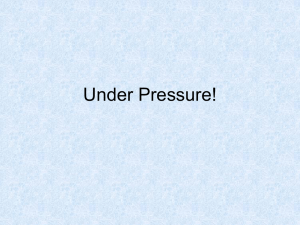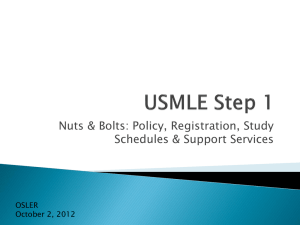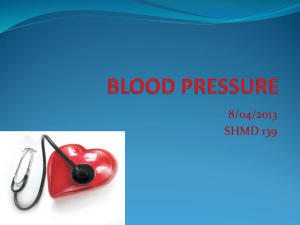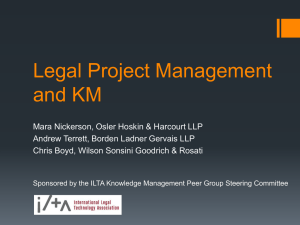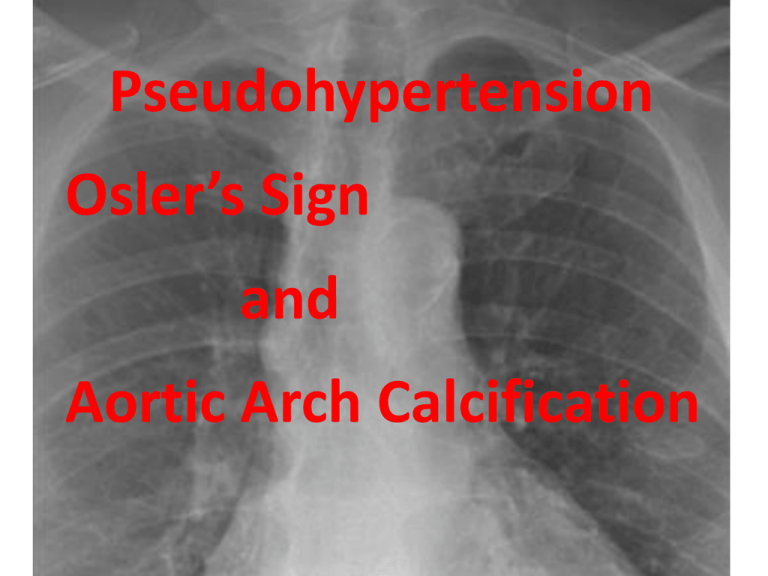
Pseudohypertension
Osler’s Sign
and
Aortic Arch Calcification
Case Report
OB – 89 y/o man admitted with SOB, cough, knee pain
Past Medical History
-
Hypertension
Mild CCF
Prostate Ca
Chronic renal impairment (Cr. 250)
Medications
ACE I
Aspirin
Amlodipine
Fruesemide 40mg
Pseudohypertension
• When BP measured by cuff is falsely elevated
compared to reference standard because of
hardened calcific arterial walls
• Pathophysiology - arterial calcification as
opposed to atherosclerosis/collagen deposition*
• Associations
– Age
– Atherosclerosis
- Hypertension
- Scleroderma
• Prevalence - 1.7% and 2.5% but poorly studied*
* Zuschke et al, Pseudohypertension, Southern Medical Journal 1995, 88:1185-90
Atherosclerotic calcification:
– Intimal layer – cellular necrosis,
inflammation and lipid deposition
– As lesion progresses, osteogenesis
– Typical vascular risk factors, especially
DM and smoking
Monckeberg’s Sclerosis
artery calcification)
(medial
– Age, diabetes and renal disease
– Related to PTH, calcium and phosphate
product, vitamin D and uraemia
– Bone-associated cells/proteins important
Osler’s Maneuver
“It may be difficult to estimate how much of the
hardness and firmness is due to the tension of blood
within the vessel and how much to the thickening of
the wall.
For example, when the radial artery can be felt
beyond the point of compression, it’s walls are
sclerosed”
Sir William Osler, 1892
Osler’s Maneuver
• Term coined by Messerli et al (N Engl J Med) in 1985:
– Oslers, sphygmo, ECHO
– Strong association between Osler’s and PsHTN
• Usefullness refuted by Prochazka et al (Clin Res) in 1987, due to poor
inter-observer reliability
• Subsequently, interobserver agreement 82% with no training effect#
• Prevalence
– 1.7%* to 12.3%** (with 0% under 50y/o and 15.6% in over 65y/o)***
– Prevalence increases with age, history of hypertension or stroke**
# Hla et al, Observer vasriability of oslers maneuver in detection of pseudohypertension, J Clin Epi 1991, 44:513-18
* Kuwajima et al, Pseudohypertension in the elderly, J. Hyperten, 1990, 8:429-32
** Wright and Looney, Prevalence of positive osler’s manouvre in 3397 persons screened for the SHEP, Journal of Human Hypertension, 1997, 11:285-289
***Prochazka et al, Oslers maneuver in outpatient veterans, J Clin Hypertension, 1987, 3:554-8
Osler’s Maneuver – previous studies
Systematic review using MEsH terms
pseudohypertension, Osler’s sign and Osler’s
maneuver revealed 8 studies:
–
–
–
–
Two examining prevalence of Osler’s sign
One examining observer variability in Osler maneuver
Four comparing radial artery to sphyg in osler-positive
One comparing radial doppler to sphyg in osler-positive
Aortic Arch Calcification
Aortic Arch Calcification
• Thoracic aortic calcification has been associated with
increased cardiovascular mortality (hazard ratio between 3 - 6
for IHD and 2.3 for CerebroVD mortality)*
• Strong association with increasing age, hypertension, pulse
pressure and smoking
• less association with other known cardiovasc risk factors and
CRP** (these studies DID NOT include renal function)
• Clear evidence of association with renal failure
- Vitamin D, PTH, calcium and phosphate, ureamia
• Genetic component***
*
*
**
***
Jacobs et al, Comparing coronary artery calcium and thoracic aortic calcium for prediction of all-cause mortality and cardiovascular events in lowdose non-gated computed tomography in a high-risk setting of heavy smokers, Atherosclerosis, 2010, 209:455-62
Calcification of the thoracic aorta as detected by spiral computed tomography among stable angina pectoris patients, Circulation, 2008, 118:1328-34
Takasu et al, Relationship of thoracic aortic wall calcification to cardiovascular risk factors: the multi-ethnic study of atherosclerosis (MESA), American
Heart Journal, 2008, 155(4)
Parikh et al, Parental occurrence of premature cardiovascular disease predicts increased coronary artery and abdominal aortic calcification in the
framingham offspring and third generation cohorts, Circulation, 2007, 116:1473-81
Oslers maneuver,
Pseudohypertension
and
Aortic Arch Calcification
Simon Quilty
Nick Collins
Nick Jackson
Paul Puller
Angela Puller
John Attia
Study Design
• Sequential patients undergoing non-emergency cardiac
catheterization in RNC Cath Lab
• Verbal consent – 100% acceptance
• Study participants underwent:
–
–
–
–
Pre-procedure questionnaire
If recent CXR in past 5 years, Aortic Arch Calcification score calculated
Pre-procedural manual and automatic sphygmo BP
Study blood pressure measurements
Peripheral transduced BP
Automatic sphygmo BP (on non-procedure arm)
Central transduced BP
Questionnaire
• Age, sex
• diabetes
• hypertension
• hyperlipidaemia
• Past or current smoking
• Number of pack years smoked
• Past history ischaemic heart disease
• Past history stroke
• Past history peripheral vascular disease
Aortic arch calcification calculation
Tetsuya et al, Simple evaluation of aortic arch calcification by
chest radiography in haemodialysis patients, Hemodialysis
international, 2009, 13:301-306
Results
Participant Characteristics
Age
Sex (female)
65.8
49
SD 12.5
35%
139
136
65
SD 25
SD 11
139
139
131
74
SD 22
SD 12
139
139
143
88
SD 67
SD 11
139
139
Oslers positive
Aortic Arch Calcification
eGFR
14
3.71
65.5
13.00%
SD 3.69
SD 20.6
109
98
119
Diabetes
Hypertension
Smoker
Pack years
Hyperlipidaemia
History IHD
History stroke
History PVD
40
71
75
18.3
54
52
14
4
32%
56%
64%
SD 19.2
45%
43%
11%
3%
125
126
118
Blood pressure (cuff)
- systolic
- diastolic
BP (transduced peripheral)
- systolic
- diastolic
BP (transduced central)
- systolic
- diastolic
121
122
122
121
Participants defined as pseudohypertension
(percent, average cuff over-estimate and range)
Peripheral transduced
Systolic
Diastolic
11%
44%
15mmHg
16.5mmHg
10-40mmHg
10-37mmHg
Central transduced
Systolic
Diastolic
17%
12%
18.4mmHg
14.4mmHg
10-39mmHg
10-26mmHg
Patients with one or more degrees of
pseudohypertension (sys, dias, periph, central)
One
Two
Three
Four
TOTAL
52
19
7
1
79
37%
14%
5%
1%
57%
Difference in characteristics based upon Oslers sign
Oslers positive
Age
Sex (female)
Oslers negative
65.7
5
SD 12
36%
65.3
35
SD 13
37%
eGFR
58
SD 17
60
SD 20
AoAC
4.4
A = 2.5
2.47
A=3
Diabetes
Hypertension
Smoker
Pack years
Hyperlipidaemia
IHD
Stroke
PVD
3
8
9
20
7
5
1
0
23%
62%
69%
A = 18
54%
9%
8%
0%
30
46
50
17
33
32
6
3
36%
55%
63%
A = 15
40%
39%
7%
4%
Statistical Analysis
• Inter-rater reliability of Osler’s Sign
– Kappa = 0.54
– Inter-observer agreement = 89%
Pearson’s correlation Sphygmo vs Peripheral Transduced BP
No correlation between systolic
Correlation between diastolic, P < 0.0001, R = 0.55
Systolic
Diastolic
Difference auto vs transduced
Difference (Automatic vs periph TD)
50
L
45
25
20
0
-5
-25
-50
-30
0
50
100
150
200
Automaitc press
Automatic Sphyg BP
0
30
60
90
Automatic Sphyg BP
120
I
Sphygmo vs Central TransducedBP
No correlation between systolic
Correlation between diastolic, P < 0.0001, R = 0.49
Systolic
P
Difference auto vs transduced
Difference (Automatic vs central TD)
50
Diastolic
56
40
25
24
8
0
-8
-25
-24
-50
-40
0
50
100
150
200
Automaitc press
Automatic Sphygmo BP
0
30
60
90
Automatic Sphygmo BP
120
I
Osler’s Sign and Pseudohypertension
• Fisher’s exact test
Pseudohypertension as defined as >10mmHg
over-estimate of reference (transduced) BP
No statistically significant association between
Osler’s Sign and defined pseudohypertension
centrally or peripherally, systolic or diastolic
Osler’s Maneuver and Pseudohypertension
• Unpaired t-test
– Osler’s Sign and magnitude of difference between automatic and
transduced BP:
– Systolic Pseudohypertension no statistically significant difference
– Diastolic pseudohypertension statistically significant when measured
centrally or peripherally
• Central – 4mmHg between osler’s pos/neg (P<0.03)
• Peripheral – 16mmHg between osler’s pos/neg (P<0.0001)
• Patients with a positive osler’s maneuver had a diastolic cuff
pressure that was on average 16mmHg above transduced
Osler’s Sign and Aortic Arch Calcification
• There was a statistically significant correlation
between a positive and negative osler’s sign
and extent of aortic arch calcification:
– Osler’s positive – mean AoAC score = 6.7
– Osler’s negative – mean AoAC score = 3.28
– P = 0.004
Stepwise Multiple Linear Regression –
Magnitude of difference in BP
•
•
•
•
•
•
•
•
•
•
•
•
•
Oslers sign +/Age
Sex
Aortic arch calcification score (0-16)
eGFR
Previous or current smoker
Number of pack yrs of smoking
History of Diabetes
History of HTN
History of dyslipidaemia
Previous history of IHD
Previous history of Stroke
Previous history of PVD
Magnitude of difference in BP Automatic vs Peripheral transduced
• Systolic
– Stroke (-9.77mmHg if +ve Hx, P = 0.01)
• Diastolic
– Osler’s Sign positive (+5.28mmHg if Oslers +ve, P = 0.07)
– History of IHD (-3.70mmHg if +ve Hx, P = 0.07)
Stepwise Multiple Linear Regression
Aortic Arch Calcification
• Same variables plus pressure difference between
sphygmo and transducer (systolic, diastolic, central
and peripheral)
• Age (+0.08 per yr of age, P = 0.03)
• Renal function (-0.06 per eGFR, P = 0.008)
• Osler’s sign (+2.32 if Oslers +ve, P = 0.07)
Conclusions
• Pseudohypertension leads to over-treatment of blood
pressure
• There is no “gold standard” blood pressure
• In high-risk patients with resistant diastolic
hypertension, an Osler’s Maneuver may be useful
• Aortic arch calcification does not assist in risk
stratifying in regards to pseudohypertension
Conclusions
Measurement of BP is imprecise however there
are strategies that improve accuracy of diagnosis*
*Powers et al, Measuring blood pressure for decision making and quality reporting: where
and how many measures? Annals of Internal Mericine, 2011, 154:781-88
Within patient SBP variance and number of measurements
*Powers et al, Measuring blood pressure for decision making and quality reporting:
where and how many measures? Annals of Internal Medicine, 2011, 154:781-88
Concurrence between automatic and
manual sphygmomanometer
Linear regression, Two-sided P <0.0001, R = -0.32 (sys) R = 0.06 (dias)
Systolic
Diastolic
Difference auto vs manual
Difference
50
F
30
25
10
0
-10
-25
-30
-50
0
50
100
150
200
250
Pre BP automatic
Automatic BP
-50
0
30
60
90
120
D
Automatic BP
Central transduced vs
Peripheral transduced BP
Close to statistically significant correlation for systolic (P = 0.051, R=0.24)
Statistically significant correlation for diastolic (P < 0.0001, R=0.48 )
Systolic
Diastolic
Difference central vs peripheral
Difference (CENT vs PERIP TD
50
S
40
20
25
0
0
-20
-25
-40
-50
-60
0
50
100
150
200
250
0
20
40
60
80
Art pres s CENTRAL
Central BP
100
U
Central BP


